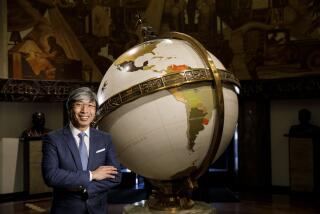William F. Thomas dies at 89; former Times chief editor
William F. Thomas, an editor who led The Times during an extraordinary period of expansion in the 1970s and 1980s, when the paper widened its reach nationally and abroad and became a showcase for literary journalism, has died. He was 89.
Thomas, who helped the paper reap 11 Pulitzer Prizes during his three-decade career at The Times, died Sunday of natural causes at his home in Sherman Oaks, said his son, Pete.
“He was perhaps the least well-known of any editor of any major newspaper,” said former Times Publisher and CNN President Tom Johnson. “He never sought the spotlight for himself. His passion was for great writing.”
The Times’ seventh editor, who led the paper from 1971 to 1989, Thomas oversaw the launch of the Sunday magazine, Book Review and daily Business and Calendar sections; opened 11 domestic and foreign bureaus; and started regional editions in San Diego and the San Fernando Valley.
With these bold steps, he pursued Publisher Otis Chandler’s ambition of putting the Los Angeles Times on the level of its more established rivals, the New York Times and the Washington Post. Chandler brought Thomas to The Times in 1962 and later surprised many newsroom veterans by choosing him to lead the paper over candidates with more lustrous, East Coast credentials.
Thomas’ tenure was notable for more than simply massive growth. He emphasized originality in reporting and writing, giving reporters the freedom to conjure stories that did not usually appear in newspapers. Often the subjects were esoteric — conjoined twins in Los Angeles, exotic commerce on the Congo River and the rugged world of commodities traders in Chicago — and took months of research, but the end results were probing, stylish stories that often ran at great lengths, jumping from one page to another to another.
Alongside breaking news and investigative reports, “there were a couple of stories in the paper every day that you might have found … only in the New Yorker or a handful of other places, that were beautifully written, deeply reported, full of insight,” said Tom Rosenstiel, a media reporter during Thomas’ years who now directs the nonprofit American Press Institute in Reston, Va. “He imagined a newspaper that had things no other newspaper had and everything any other newspaper had.”
In an age increasingly dominated by television, Thomas believed that newspapers had to break with rigid formulas of the past —”the stiff-necked approach to news,” he once called it. He was not a fan of market research, instead championing story ideas that he personally found interesting or important.
“He figured that in a metropolis the size of Los Angeles, there would always be enough people who shared his interests and taste to make the paper successful,” David Shaw, then The Times’ media critic, wrote shortly after Thomas retired.
His Times had detractors, however. Critics, including some inside Thomas’ own newsroom, were skeptical that anyone wanted or needed to read several thousand words on the advent of television in Samoa or a teenage murderer from Mesa, Ariz. Editors at rival newspapers found ways to nettle the biggest paper in town by emphasizing punchy, local stories that they said The Times ignored in its rush to become nationally respected and journalistically different.
One of these stories concerned Eulia Love, a South Los Angeles woman who was shot to death by police officers in a 1979 confrontation over an unpaid $22 gas bill. The Herald Examiner made the controversial shooting front-page news, but The Times buried it at first, which contributed to its reputation as a “velvet coffin” where success had bred journalistic complacency. Peter J. Boyer, who wrote for the Los Angeles Times and later the New York Times, called the West Coast paper during the Thomas years “the Club Med of journalism.”
This criticism — that The Times ignored or was slow to cover major stories in its own backyard — was ironic given Thomas’ background in local news.
Thomas was born in Bay City, Mich., on June 11, 1924, the son of a bank vice president. He earned bachelor’s and master’s degrees in journalism from Northwestern University and worked at newspapers in Buffalo, N.Y., and in Sierra Madre before becoming editor, in 1957, of the Los Angeles Mirror, an afternoon paper owned by the Chandler family. When the Mirror closed in 1962, Chandler, who had become Times publisher two years earlier, brought Thomas to the larger morning paper.
He became assistant city editor in 1962 and metropolitan editor in 1965, just before the biggest local story of the year erupted — the Watts riots.
The Times’ coverage of the riots brought the paper’s first Pulitzer for local reporting, in 1966. It was one of two local Pulitzers the paper would win while Thomas was metro editor.
In praising the Watts coverage, the Pulitzer panel said the paper had demonstrated “alertness, resourcefulness and high quality of writing.” It was the latter attribute that Thomas particularly wanted to hone. “When I became city editor,” he said in a 2002 interview with The Times, “what I wanted to do more than anything else was hire people who could write.”
He recruited talented writers from underground and alternative papers as well as mainstream dailies, and gave them creative license, with results that baffled and appalled newsroom traditionalists. A lengthy, impressionistic account of hippie life in San Francisco in 1967 by poet-cum-reporter Dave Felton was Thomas’ cue that The Times was a-changing.
Mirroring techniques that Tom Wolfe and other New York writers had begun using in the early 1960s, Felton’s “Haight-Ashbury Revisited: Some Observations in the Week After the Death of Chocolate George” read more like a script than a typical newspaper story, interspersing chunks of dialogue with the writer’s own observations in italics and parentheses.
The paper became a showcase for gifted journalists such as Dave Smith, Charles T. Powers and Bella Stumbo, whose dogged reporting and compelling narrative styles set new standards for the paper.
“It was great to be a writer for Bill Thomas. Bill loved a good story and he loved good writing,” former Times reporter Richard E. Meyer said. Meyer sometimes spent a year on a single assignment, such as the time Thomas suggested he examine “the ebb and flow of patriotism in the U.S.” The result was a Page 1 story in 1984 that examined patriotic fervor in the Reagan era.
“If you were accurate, if you told the whole story, if you left your biases at the door, Thomas and his editors would let you take a story wherever it went — literally — back in an era when money was no object,” recalled Dennis McDougal, a former Times staffer and Otis Chandler biographer.
There was nothing flamboyant about Thomas. He lacked the combative personality of New York Times editor A.M. Rosenthal. He wasn’t played by Jason Robards in a movie, as was the Washington Post’s Benjamin C. Bradlee. Yet Thomas was a man of some complexity: confident and decisive, but also so shy and private that some staffers nicknamed him “invisi-Bill.” Indeed, his office wasn’t even in the newsroom but on the second floor near the publisher’s suite, where he believed he could better protect newsroom interests from misguided business schemes.
A World War II veteran who was a longtime resident of the San Fernando Valley, Thomas was predictable in his personal habits: He played golf every Saturday with his male friends and every Sunday with his wife, Pat, to whom he was married for 52 years; and he vacationed in Oceanside for three weeks every August.
He was not Chandler’s first choice when the publisher began considering candidates to succeed editor Nick B. Williams.
The heir apparent was Robert J. Donovan, the paper’s highly respected Washington bureau chief who left that job to become executive editor in Los Angeles. But, as Chandler gradually realized, Donovan rubbed some Chandlers the wrong way. He also didn’t know Los Angeles.
Thomas, on the other hand, “knew the city and the greater community far better than any of the Easterners,” David Halberstam, in his classic media study “The Powers That Be,” observed. “He was very smart and very ambitious and yet he was never contentious.”
When he was named editor in 1971, many of Donovan’s friends and colleagues were angry with Chandler — and Thomas. But under his leadership, The Times won more Pulitzers than it had in the preceding eight decades. One was the gold medal for meritorious public service for a series on Southern California’s burgeoning Latino community, awarded in 1984.
Thomas lamented The Times’ failure to gain as much respect as he felt it deserved among East Coast opinion-makers — partly a function of his reluctance to take as visible a role in newspaper organizations and events as some of his counterparts did. But the paper’s excellence was noticed.
Thomas, the Post’s Bradlee said later, had presided over The Times “at a time when it became a great American newspaper.”
During his 27 years at The Times, he had seen dramatic changes, including a rise in circulation from 757,000 daily subscribers in 1962 to more than 1.1 million in 1989.
He left his position eagerly, on Jan. 1, 1989, six months before his 65th birthday. By then, the climate for “a special kind of journalism” — the slogan for a long-running advertising campaign touting The Times’ literary aspirations — had begun to deteriorate.
During the 1990s and 2000s, his successors battled with cost-conscious publishers who were not named Chandler and began to preach limits — something Thomas had not known during the golden years of expansion under Otis Chandler.
There was no way back to that era, when print journalism still ruled and a determined editor like Thomas could, as he once told Los Angeles magazine, “put out the paper we wanted to put out, with few restraints and lots of encouragement.”
“My style was to do the job and push the boundaries,” Thomas reflected in 2006, when Chandler died, “and once Otis realized I knew what I was doing, he let me do it.”
His wife, Pat, whom he married in 1948, died in 2000. He is survived by sons Michael, Peter and Scott and a granddaughter, Kasey.
More to Read
Start your day right
Sign up for Essential California for the L.A. Times biggest news, features and recommendations in your inbox six days a week.
You may occasionally receive promotional content from the Los Angeles Times.







